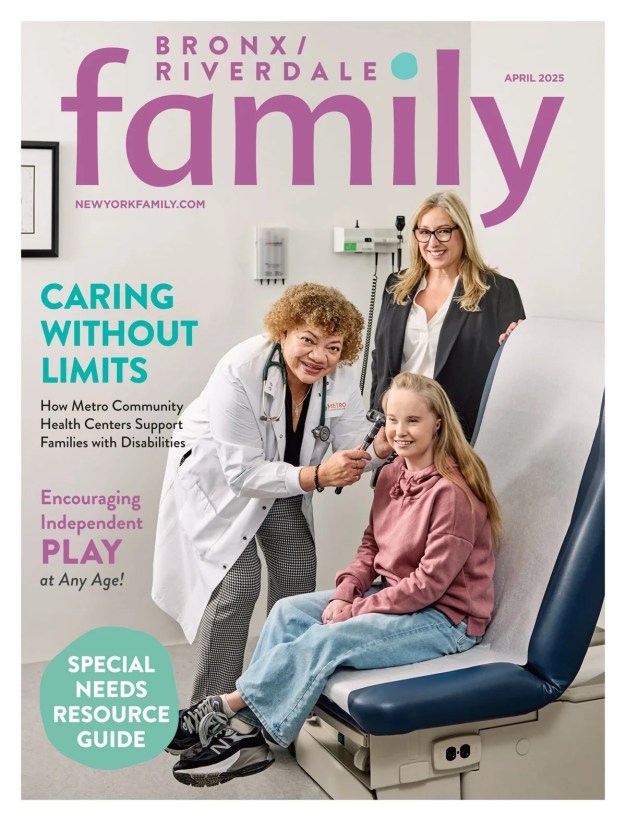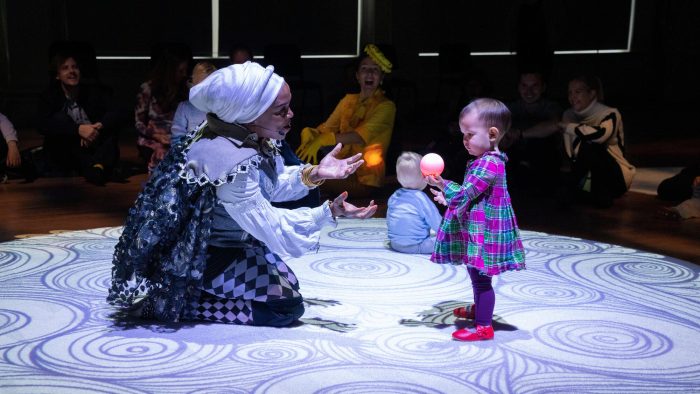 We all know that New York City is home to a host of world-class hospitals. To help you get to know them better, we offer a slice of each hospital that is relevant to families, from a unique adolescent mood disorder program to a full-service epilepsy center to a highly successful in vitro fertilization clinic. We hope that you won’t be needing any of these services anytime soon, of course, but there’s comfort in knowing that they’re here, and they certainly make for an interesting, topical read.
We all know that New York City is home to a host of world-class hospitals. To help you get to know them better, we offer a slice of each hospital that is relevant to families, from a unique adolescent mood disorder program to a full-service epilepsy center to a highly successful in vitro fertilization clinic. We hope that you won’t be needing any of these services anytime soon, of course, but there’s comfort in knowing that they’re here, and they certainly make for an interesting, topical read.
NYU Langone Medical Center
Pediatric Otolarynology (Ear, Nose, and Throat)
Scott M. Rickert, MD, Acting Director
What kinds of ailments do you see most often among the young patients you receive?
The most common things I see are ear infections, tonsil infections, and various breathing issues.
Within these conditions, what red flags or symptoms should parents know to look for?
For ears, the big concern is recurring infections—if your child has experienced more than three or four ear infections in a calendar year, you’d want to see an ENT specialist. If your child’s speech is delayed or they’re not hearing well, it can either be an issue with their true hearing or with fluid that hasn’t cleared from a prior infection.
From the breathing standpoint, sleep deprivation is a common symptom. That can manifest in either fatigue or hyperactivity from sleep deprivation. It’s not always ADHD when you’re dealing with hyperactivity; sometimes it can come down to an actual breathing issue.
What advice can you offer parents in terms of preventative or preemptive measures?
Ear and tonsil infections often start out as a cold, which can drift to the ears or chest and become an infection. Some of that is just bad luck and some of that can be linked to genetics, or sometimes if the child has one bad ear infection, residual fluid can linger in the ear. It doesn’t take a lot of fluid in the ears to cause problems. Every child can be sick seven or eight times per year. You try to keep them from re-infecting themselves, by keeping their hands off their face and out of their mouths.
—Nick Bell
NewYork-Presbyterian Hospital
Columbia University Medical Center
Sports Medicine Center for the Developing Athlete
Charles A. Popkin, MD, Assistant Professor
What distinguishes your program from other similar services?
We don’t have just a couple of orthopedic surgeons; we have different fields in providing sports injury coverage for sports like soccer, hockey, lacrosse, baseball, and football. We have people at a national level who enjoy making sure kids are healthy and getting them back on the playing field.
What common problems do child athletes face?
A lot of overuse injuries, such as stress fractures, Sever’s disease, and Osgood-Schlatters. A lot of times, baseball players keep pitching while some coaches ignore the pitch count guidelines. This puts them at risk for something called Little League Shoulder, which is a growth plate injury in their proximal humorous. Our current efforts are focusing on minimizing overuse injuries. For example, USA baseball has recommended that youngsters should only be pitching nine months of the year.
What are some red flags that parents of child athletes should look about for, and at what age?
We’re seeing kids with knee injuries as young as six or seven. If a child is participating in sports and they’re complaining of a pain or limping, they should come in and get checked out.
What are some basic preventative measures every growing athlete should be aware of?
What we’re taking seriously now are young female soccer players ages 14-18 and their ACL reconstruction results. They have a higher rate of tearing their ACL than their male counterparts. A couple of things are being done in Europe, such as the FIFA 11 warm-up program, where they have studies that actually decrease ACL injury rates.
—Pearl Shin
NewYork-Presbyterian Hospital/Weill Cornell Medical Center
Pediatric Comprehensive Epilepsy Center
Juliann M. Paolicchi, MD, Director
What qualities distinguish your program?
We have a Comprehensive Pediatric Epilepsy Program. It’s an Ivy League medical institution with top-notch research at the forefront of translational research. We have the ability to handle somebody with a mild case to somebody who has seizures really destroying their life. And we keep in mind that we’re working with children; we’re very honest about what procedures are necessary or not.
What you mean when you say “comprehensive”?
All areas of treatment and investigation are available. We offer in-house education, then we have all kinds of standard medications and, if those fail, clinical trial medications. We have a nationally recruited nutritionist trained in dietary treatments for neurological diseases—some patients can be effectively treated through dietary needs. Lastly, we offer surgical implantation of epilepsy devices and evaluational treatment through surgery.

What warning signs should parents know?
There can be many different kinds of seizures, [but] almost all seizures are characterized by a sudden loss of responsiveness—if you touch the patient and they don’t respond. Often there’s a change in their face, a lack of responsiveness in their eyes, drooling, smacking lips, eyes moving to one side, movements of the hand.
What are the major differences between adult and pediatric epilepsy?
We’re learning more and more that many forms of pediatric epilepsy are genetic, so we’re going more quickly to genetic testing to and modifying our treatments for those genetic epilepsies. [In children], there is also a lot more “benign epilepsy” that goes away. It makes it a very hopeful field to work in.
What might people be surprised to know about living with epilepsy?
It’s very common for patients to lead normal lives after receiving treatment. We encourage patients to participate in sports—it’s good for stress relief, good for overall health, and research shows that it reduces patient seizures.
—Tashween Ali
St. Luke’s-Roosevelt Hospital Center
Continuum Reproductive Center (In Vitro Fertilization)
Martin D. Keltz, MD, Director
What qualities distinguish your program?
Ours is a sizable program with over 500 IVF cycles completed in 2012, with successful clinical pregnancies in about 50% of our patient cycles up to 37 years old and 25-30% in patients ages 38-42. We strive to maintain the feel of a more intimate practice, with physicians following their own patients throughout their cycles and generally performing the embryo transfer on their own patients.
What steps are taken before IVF becomes the best option?
The two indications for going directly to IVF in infertility are irreparable bilateral tubal damage and severe male factor. Young couples with at most one year of unexplained infertility may continue to try without treatment, then for those couples who fail 3-6 cycles of lesser treatment and have no surgically correctable cause of infertility, we proceed to IVF.
What are common myths that people have about IVF that you would like to dispel?
One common concern about IVF is that it invariably results in multiple pregnancies, when in fact we can choose to transfer only one embryo in younger women and perhaps two in older women and freeze additional embryos for a later transfer. Cost is a major worry; the good news is many insurances cover part or all of the procedure.
A number of recent articles have cited connections between IVF and autism, birth defects, and other post-natal problems. Can you speak to this?
Some papers have shown that IVF pregnancies, regardless of the use of ICSI (intracytoplasmic sperm injection), are associated with a small increase in major malformations. The most recent significant publication this past year found IVF with ICSI—but not standard IVF— associated with an increase in major malformations. The biggest problem is interpreting the data. Long-term follow-up studies in IVF children are just making their way into the literature now, so we are still in the learning phase.
—T.A.
Beth Israel Medical Center
Cystic Fibrosis Center
Patricia Walker, MD, Co-Director
What makes your center unique?
We are unique because our team is dedicated on a full-time basis to caring for patients with cystic fibrosis (CF). Our expertly trained and experienced staff has cared for hundreds of CF patients who hail from all over the world, providing a state-of-the-art treatment approach and comprehensive supportive services.
What are the signs of CF parents should look for?
The most classic presentation of CF in infancy is failure to thrive, when the child is unable to absorb the food he/she eats leading to multiple stools and weight loss. There are many other features that can occur, depending on the genetic defect that is inherited. CF is a multi-system disease and can present in a variety of ways, such as chronic sinus, respiratory, gastrointestinal, and reproductive issues.
What is your approach to treating children with CF?
CF is a genetic disease and can now be diagnosed at birth via newborn screening—and therapies can start as soon as possible to improve the outcome. Creating an environment of support to help the families balance the daily routines is critical. Children and adults with CF receive the same therapies of airway clearance, nutritional, social work, genetic and wellness support as an added benefit of our combined model of care.
How does CF affect a child’s lifestyle?
Children with CF attend school, get involved with sports and activities, and make friends in the same way other children do—and can expect to live normal, active adult lives. Our team helps our young adults transition in to college and the workforce. While the new graduate is job seeking, they can work with our social worker to make sure their access to healthcare services is uninterrupted. In addition, people with CF can have healthy children.
—Christine Wei
Mount Sinai Medical Center
Pediatric Mood and Anxiety Disorders Program
Vilma Gabay, MD, Chief
Tell us about your program. What disorders do you deal with?
This is a new program at Mount Sinai providing comprehensive treatment for adolescents with modern anxiety disorders, which are very common in the age group. I’m talking about anxiety, which can be involved around multiple diagnoses, and mood disorder, which can be aggressive in adolescence and then continue into adulthood. Another disorder is depression, a leading cause of death, associated with so many serious consequences—like social withdrawal, drug use, the inability to go to school—affecting every aspect of life.
What kind of treatment do you provide?
We provide evaluation and a different kind of therapy—a multi-model treatment. We start with the right diagnosis, then provide therapy along with medication management. We tailor the treatment to the patient, we provide cognitive neuro-therapy, we provide family therapy, and we work with the school.
What else distinguishes the program?
We have several cutting-edge research programs using evidence-based treatment (using evidence from the individual’s symptoms) combined with research-based treatment, including imaging MRIs that allow us to look at different brain functions and chemicals in the brain in detail. Our research is also done in adolescents, whereas most research on mood disorders is done in adults—most times we see the symptoms of disorders start during or after puberty. Third, we don’t investigate only the neurobiology of the mood disorder, but we also investigate the specific symptoms and the severity of the symptoms.
What are the symptoms parents should look for?
Inability to experience pleasure; difficulty with concentrating; getting behind in school; social anxiety; trouble sleeping; acts of rebellion like using drugs. I’d advise contacting the child’s pediatrician.
—T.A.
Lenox Hill Hospital
Obstetrics & Gynecology
Michael Y. Divon, MD, Chairman & Program Director
What makes your maternity services stand out?
We were the first in town to put what is called a “Cold Stop” to not deliver before 39 weeks.
Please expand on this new policy regarding non-medically necessary elective deliveries.
Over the past decade, it’s become fairly common to deliver babies before 39 weeks of gestation—it’s an issue of convenience, both for the patient and the doctor. Many patients want their lives scheduled, rather than wait for the unknown. But some publications recently documented that deliveries before 39 weeks are associated with outcomes that are not as good as [those] after 39 weeks. In order to overcome this potential suboptimal outcome, if there are no indications that patients have gotten to labor—for example, if the patient has preeclampsia uncontrolled diabetes and so forth—we don’t want to deliver before 39 weeks, whether it’s induction of labor or a Cesarean section.

What should parents know about the new policy?
The main point that people should know is that gestational age (how pregnant you are) should be established in early pregnancy, because if you establish it late in pregnancy, it’s not that accurate.
How does this policy change parents’ pregnancy planning and choosing a hospital?
You just can’t bring in the patient before 39 weeks. Toward the end of pregnancy, many patients become impatient, but everyone [still] has to wait 39 weeks now. (There have been no complaints so far.)
—T.A.
Memorial Sloan-Kettering Cancer Center
Immunology (Adoptive Cell Therapy)
Richard J. O’Reilly, MD, Chair of Pediatrics, Chief of Bone Marrow Transplant Service
Tells us about your program. What distinguishes it?
Here at Memorial, there is a series of studies focused on how we can potentially use immune cells to deal with either life threatening infectious complications or tumors. Some of the major things we’re doing: one, using genetically modified immune cells either from the patients or donors to target selective cancer cells and, two, using immune T-cells to deal with life-threatening infectious diseases with patients who have compromised immune systems. We are currently pursuing clinical trials in adults and children—the major emphasis is to try to increasingly target the bad cells and leave the normal cells free to develop.
What makes adoptive cell therapy treatments different from other cancer treatments?
The genetically engineered cells are not broadly reactive or toxic and will only kill cells that are targeted through this genetically modified receptor. They’re also living cells that grow up to be significant populations that can stay in the body for a long time—months to years—providing ongoing protection against the regrowth of leukemic cells.
What should families, parents, and caregivers know about this new research?
We are now starting trials of using humanized monoclonal antibodies, made by identical immune cells that are all clones of a unique parent cell, in therapy for children with neuroblastoma. Many years ago, the active cells used were derived from mice, and some people become immune to the mouse protein or are allergic. These new humanized antibodies are much more applicable for those patients and can last longer in the body with lower risks of becoming immuned by the patient.
Who is the ideal candidate for this therapy?
Ideal candidates are patients with leukemia, certain forms of lymphoma, prostate cancer. Children born with severe deficiencies or developed deficiencies as a result of marrow organ transplants are also good candidates.
—T.A.
New York Downtown Hospital
Obstetrics & Gynecology
Carmen J. Sultana, MD, Chairman
What are your department’s outstanding qualities?
Our department is part of NY Downtown Hospital, which is the only hospital in lower Manhattan. Unlike at many other hospitals, Ob/Gyn and Maternal Health are very important to our hospital and make up about 25% of the admissions. We do a high volume of deliveries in a warm, patient-focused setting committed to the local community. The hospital is in the heart of the Financial District and is easy to reach from Upper Manhattan, Brooklyn, and New Jersey.
Any major developments in the department in recent years? We heard, for example, that patient enrollment is increasing. Why do you think that is?
Enrollment has been increasing, and part of it is certainly due to the increasing residential flavor of the neighborhood. But our most exciting development is the hospital’s partnership with NewYork-Presbyterian hospitals and the Weill Cornell Medical College.
Does the department offer any education classes that expectant women should know about?
We offer the full range of postpartum and lactation education, with on-site consultants, and look forward to expanding these in the future.
What should parents know about adolescent gynecology?
Adolescent gynecology takes a special touch. Even though pap smears are not the critical part of the picture now for adolescents that they used to be, these patients benefit immensely from a caring provider to help and counsel them through issues of identity and sexuality and body image—and to help guide them through issues of contraception and prevention of complications of risky behavior.
—Eric Messinger
New York Eye & Ear Infirmary
Pediatric Otolaryngology
Joseph M. Bernstein, MD, Director
Tell us about New York Eye & Ear Infirmary. What qualities distinguish it from other ENT providers?
The New York Eye & Ear Infirmary is one of a handful of specialized hospitals devoted to medical and surgical care of the ears, nose, throat, and eyes. Given our hospital’s focus, we see a much larger volume and more varied spectrum of ENT disorders than most other hospitals. Our physician and ancillary staff’s expertise is at the cutting edge of the specialty.
What kind of ailments do you see most often?
We see a great number of routine pediatric problems involving infections of the ears, tonsils, and sinuses. Additionally, complex and rare conditions such as profound hearing loss, cleft palate, neck masses, and airway disorders are routinely treated at the Infirmary.
What preventative measures can parents take to help kids avoid these common issues?
It is particularly important for kids who are ill to avoid contact with other children. Parents should make wise decisions about keeping their ill children out of school and about cancelling play dates.
Are there any services that parents might be surprised to learn that the center offers?
In addition to expert medical and surgical care of a wide range of pediatric ENT disorders, we also have superb pediatric audiology, speech and language pathology, a sleep disorders center, and a pediatric accredited radiology facility.
What else would parents want to know about taking their child to see an ENT specialist?
Parents should be aware that they often have options in the treatment of their child’s ENT problem. Similar symptoms and presentations may lead to surgical intervention in one child, medical treatment in others, and careful observation in some cases. This family-centered approach to pediatric ENT care is the hallmark of my practice and a mission I try to impart at the Infirmary.
—C.W.























